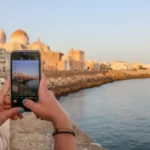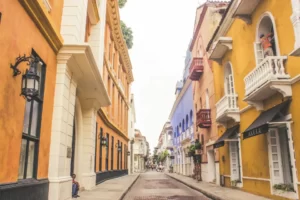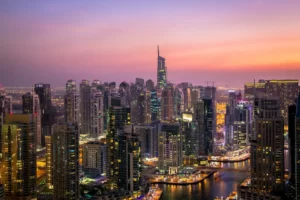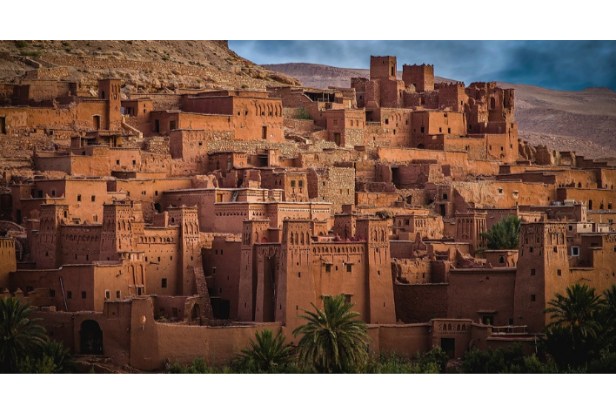
Morocco has a subtropical climate, which features hot summers and mild winters with typically year-round sunshine. The best time to travel to Morocco to trek the Atlas Mountains, the coast, the Sahara Desert, and attend local festivals and events is to check this guide first.
Morocco has four seasonal seduction abilities. We’re talking baking, breezy, or even blizzards with two distinct climate zones, the High Atlas dividing the nation, and the Sahara extending toward the coast. The best time to visit Morocco, though, can be said to depend on the season. You are cooled off in the summer by the Atlantic winds or the High Atlas elevation. In the deserts and on flora-filled hikes, springtime brings a cooler atmosphere. If you need an elixir to get you through the cold, miserable months, the coasts are mild in the winter.
The Weather in Morocco
The weather in Morocco is frequently cited as the most important factor when choosing the best time to visit. Morocco follows the same basic seasonal pattern as any other Northern Hemisphere country, with winter lasting from December to February and summer lasting from June to August.1
It can get uncomfortable hot during the summer, especially in Marrakesh, Fez, and southwest Morocco (keep in mind that the farther south you go, the closer you are to the Sahara Desert). The cool ocean breeze makes coastal locations like Tangier, Rabat, and Essaouira a more comfortable option at this time of year. Because it coincides with the summer vacation in Europe, a lot of people decide to travel to Morocco at this time despite the heat.
A dusting of snow is not unusual in northern Morocco, and of course, the Atlas Mountains are prone to heavy snowfall in the winter. Winters are generally mild, but temperatures at night can fall dramatically, with record lows of 30 degrees Fahrenheit being recorded in Marrakesh. Even skiing is available in Oukaïmeden, which is about 50 miles south of Marrakech. The country’s northern regions and the coast can experience fairly wet winters, whereas the southern region experiences drier but colder winters, particularly at night.
When is the Best Time to Visit Morocco?
Spring and fall are the most popular seasons for a Morocco adventure, with kimkim travelers choosing Their favorite vacation months are May and September. The weather is at its best countrywide, where the nights in the Sahara won’t be as chilly as in the winter nor sweltering hot in the summer, and the beaches remain inviting, though best visited in September.
Meanwhile, touring the cities during these months is relatively enjoyable with the more agreeable weather; it’s less sweltering inland in places like Fes and Marrakesh during the day. Earlier in spring and later in fall (aside from during holidays) may also net you cheaper rates on tours and lodging. That said, Morocco is a destination worth visiting at any time of year, as long as you take into account the varied climate and weather of the country’s different regions—from the Atlantic and Mediterranean coasts to the dunes of the Sahara and the interior’s mountainous region, and organize your trip accordingly.
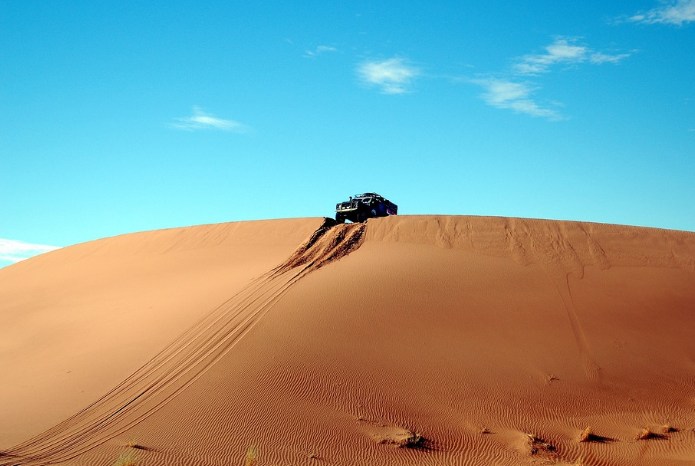
The Best Time to Trek the Atlas Mountains
Despite the fact that it is possible to hike in the Atlas Mountains year-round, the best seasons are typically spring (April to May) and fall (September to October). Although summers in the Atlas Mountains are typically mild and sunny, temperatures in the mountain valleys frequently exceed 86 degrees Fahrenheit, and afternoon thunderstorms are not unheard of. Weather in the Atlas Mountains can be unpredictable at any time of year, and conditions greatly depend on what elevation you’re planning to trek to. In the winter, nighttime temperatures can drop to 41 degrees Fahrenheit or lower, and snow precautions, including crampons and ice axes, are required above 9,800 feet.3
The Best Time to Visit the Coast
Weather-wise, the best time to visit Morocco’s beaches is during the summer, when average temperatures of around 80 degrees There are many opportunities to get some sun and get away from the stifling heat of the interior of the country in Fahrenheit. Summer is also peak tourist season, so make reservations well in advance, especially if you intend to visit popular destinations like Essaouira or Agadir. Sea temperatures are also at their warmest during this time of year, with the average water temperature for July recorded at 70 degrees Fahrenheit. Consider a trip in the spring or fall if you’d rather avoid the crowds and pay less.
People who are drawn to the Atlantic coast because it is known as one of Africa’s top surfing locations should disregard the advice given above and visit popular locations like Taghazout and Agadir in the winter. At this time of year, the swell is consistently good, and surf breaks are operating at their peak. With an average December sea temperature of 65 degrees Fahrenheit at Taghazout, a thin wetsuit is usually enough to keep out the cold even in the depths of winter.5
The Best Time to Visit the Sahara Desert
Fall or early spring are the most comfortable times to visit the Sahara Desert if you’re thinking about taking a trip there. By doing this, you’ll be able to avoid the bitterly cold nights of winter and the bone-dry landscapes and sweltering temperatures of summer (which average around 115 degrees Fahrenheit). However, it’s best to pack a warm jacket regardless of when you intend to travel. Although it’s generally a good idea to visit the desert in the spring, it’s important to keep in mind that the Sirocco wind’s sandstorms, in particular, can occur in April.
Morocco’s Festivals & Events
Morocco is home to a whole host of exciting annual festivals, some of which are well worth planning your trip around. Some festivals, like the Erfoud Date Festival and the Kelaa M’Gouna Rose Festival, are tied to the harvest and happen every year in the same month (these particular festivals fall in April and October, respectively). Others, like the Marrakesh Popular Arts Festival and the Essaouira Gnaoua and World Music Festival, are summer extravaganzas that depend on good weather to hold outdoor performances and events. Islamic holidays like Eid al-Adha and Ramadan also occur at specific times of the year and provide a fascinating look into Moroccan culture.
Spring
In Morocco, springtime is warm and dry. Only the mountain’s highest peaks have snow left, and while the ocean’s temperature has dropped, it’s nothing a wetsuit can’t fix. The spring also has fewer people.
Events to check out:
- The Gnaoua Music festivals, which fuse contemporary music with ancient traditions, are held in Fez every May or June.
- In the spring or early summer is when Ramadan usually occurs.
Summer
In particular the farther inland you go, Moroccan summers can get quite hot. Summer is a popular time for families because of the school breaks, so hotels and resorts, especially those with pools, will quickly sell out.
Fall
Both the cities and the coast of Morocco are beautiful in the fall. It’s also the perfect time for those interested in beautiful hiking weather because of the cooler, dry temperatures.
Events to check out:
- September marks the three-day holiday known as Eid al-Adha. Animal sacrifices are performed by Muslims across the nation to honor Abraham.
Winter
Due to the generally mild temperatures and low tourist traffic, traveling to Moroccan cities in the winter can be quite pleasant. At higher elevations, snow will fall, and the desert’s nighttime temperature will drop.
FAQs of Morocco Travel
Where is Morocco Located?
Morocco is a nation in northern Africa that borders the Atlantic and Mediterranean seas.
When is the Best Time to Visit Morocco?
A trip to Morocco is never a bad idea. However, the best times to travel are in April and May, or in September and November, when there are fewer tourists and lodging and air travel costs are lower.
When is the Rainy Season in Morocco?
Morocco typically experiences rainy weather from October through April. However, because the majority of Morocco is located north of the Western Sahara Desert, this season is only moderately rainy.
What Airlines Fly Directly into Morocco?
Air France, Emirates, Delta, British Airways, Iberia, Lufthansa, KLM, TAP Portugal, and Aeroflot are just a few of the airlines that fly tourists from around the world to Morocco.
What is the Best Time to Visit Morocco Marrakech
The best times to visit Marrakech are from March to May and between September and November. The low 70s to low 90s on average for daytime temperatures during these shoulder seasons make for pleasant weather and moderate hotel prices.
Is December a Good Time to Visit Morocco?
If you’re looking for the best time to visit Morocco, it’s got to be the winter months. The Atlas Mountains are fully visible against the clear blue sky from December to February, the weather is warm and mild, and there are fewer tourists.
Is November a Good Time to Visit Morocco?
With few crowds and comfortable temperatures throughout much of the country, November is a good time to visit Morocco. Furthermore, there will be fewer tourists and pleasant, sunny weather for visitors interested in visiting the Sahara Desert. For the best sights and activities, consult this monthly guide.


